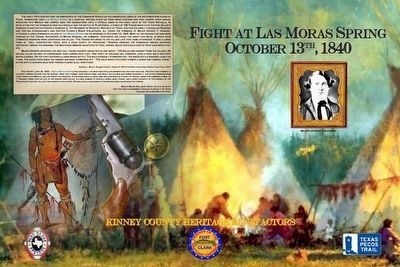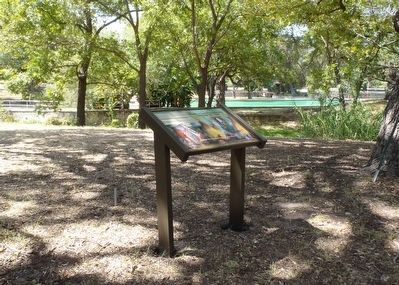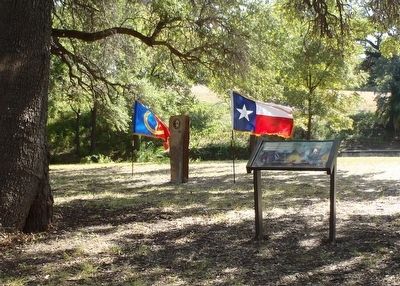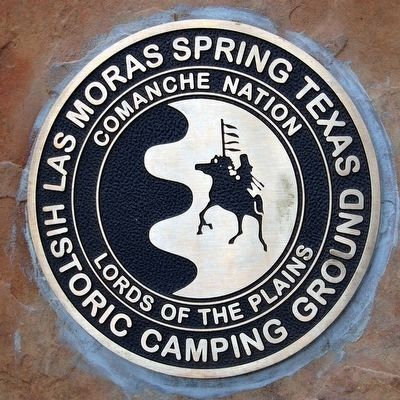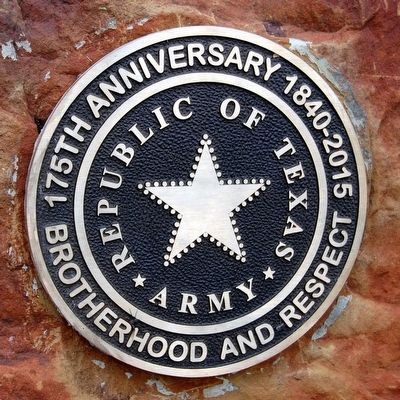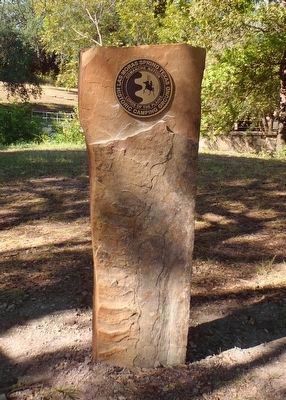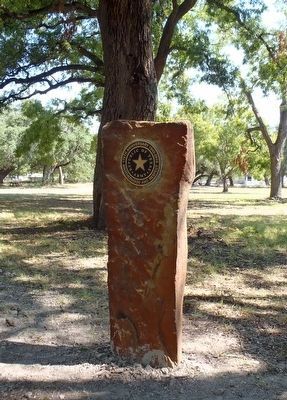Near Brackettville in Kinney County, Texas — The American South (West South Central)
Fight at Las Moras Spring
October 13th, 1840
The early 19th century saw the emergence of the Comanche people as the undisputed lords of the Southwestern Plains of Texas. Comanches used Las Moras Spring Habitual resting place on their great eastern war trail during their annual migration into Mexico and camped here for generations until a fateful dawn in the early days of the Texas Republic. In retaliation for the Comanche raid on Linnville and the Battle of Plum Creek, a force of 180 Texans made up of Captain Gillen’s Company A and Captain Ogden's Company C, 1st Regiment of Infantry, Republic of Texas, Captain Caldwell's Gonzales Rangers and Captain Cunningham's and Captain Flores's Bexar Volunteers, all under the command of Major George T. Howard, attacked a large Comanche village at Las Moras Sring on the morning of October 13, 1840. Most of the Indians fled and were pursued by the Texans. According to Major Howard, his command "continued the chase for about five miles, in which four Comanche warriors were overtaken and killed.” The Texans returned to the village late that same afternoon. It was a large town of "well constructed tents, with a good supply of provisions.” Howard ordered the Comanche winter quarters destroyed. Among the wigwams, the men found immense quantities of food, horses, mules and even a kind of fruit cake which they ate.
Major Howard departed the next day, taking several Indian rifles and about "125 mules and horses” from the village. He did not allow his men to overburden their horses with loot. One party of soldiers did, however, load a pack mule high with buffalo robes. On top they fastened a large brass kettle. The mule suddenly stampeded off, the brass kettle banging loudly as it ran. The noise frightened the horses and many stampeded off. "The race which followed formed a queer and comical scene,” as the kettle-banging mule sent horses fleeing in all directions.
Stephen L. Moore, Savage Frontier, volume III 1840-41 (Denton; University of North Texas Press, 2007)
Post Script, June 30, 1849 – It [Las Moras Spring] was decidedly the most beautiful encampment we have had thus far. This spot was formerly a favorite camping ground for the Indians. Here they formed their winter camp, and while the old men and women guarded it, the active warriors made their forays into Mexico, and laid waste the frontier. A few years since a large camp was surprised by a party of Texans, under the command of Maj. G. T. Howard. Some four or five of the Indians were killed. A large number of buffalo robes, many ponies, and a great quantity of the kernels of the pecan ready for use, fell into the hands of the victors. Several skulls and bones of the Indians were found
near the stream.
Brevet Major William S. Henry, 3d U.S. Infantry with the great government train on its march to El Paso building the lower military road
(caption)
Major George T. Howard
Erected 2015 by Kinney County Heritage Benefactors. (Marker Number 1.)
Topics. This historical marker is listed in this topic list: Native Americans. A significant historical date for this entry is October 13, 1840.
Location. 29° 18.51′ N, 100° 25.227′ W. Marker is near Brackettville, Texas, in Kinney County. Marker can be reached from the intersection of Military Highway (U.S. 90) and Fort Clark Road, on the right when traveling east. Monument and signage are located in Rendezvous Park in the Fort Clark National Register Historic District. The site is accessible from Swim Park Lane by crossing the footbridge at the Las Moras Spring Texas Historical Marker. Touch for map. Marker is in this post office area: Brackettville TX 78832, United States of America. Touch for directions.
Other nearby markers. At least 8 other markers are within walking distance of this marker. Las Moras Spring (about 400 feet away, measured in a direct line); Officers' Club Open Mess (about 400 feet away); 2nd Cavalry Division at Fort Clark (about 500 feet away); Seminole-Negro Indian Scout Detachment (about 600 feet away); U.S. Army Unit Memorial (about 600 feet away); Army Service Club (approx. 0.2 miles away); Fort Clark Historic District (approx. 0.2 miles away); Officers Quarters 2-3 and 4 (approx. 0.2 miles away). Touch for a list and map of all markers in Brackettville.
More about this marker. The site overlooks Las Moras creek. The monument is a large limestone monolith with a bronze plaque mounted on each side. The interpretive signage faces the monument and the Fort Clark post swimming pool.
Credits. This page was last revised on March 25, 2023. It was originally submitted on October 12, 2015, by William F Haenn of Fort Clark (Brackettville), Texas. This page has been viewed 845 times since then and 33 times this year. Last updated on March 25, 2023, by William F Haenn of Fort Clark (Brackettville), Texas. Photos: 1, 2, 3, 4, 5, 6, 7. submitted on October 12, 2015, by William F Haenn of Fort Clark (Brackettville), Texas. • James Hulse was the editor who published this page.
